Culture
Managing the vines
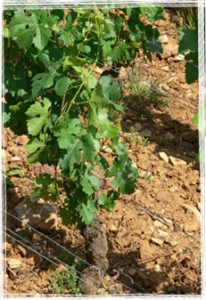
“Vine cultivation is extremely important and must be done in harmony with man and terroir(…) Pinot is a difficult varietal to cultivate, it is the most capricious but also the most fantastic.”
Concerned about practising a viticulture that is more respectful of man, vine and terroir, Anne Gros has taken a keen interest in biodynamic and organic viticulture. Though she believes this philosophy of cultivation is vital for the preservation of the terroir’s biodiversity, she refuses to categorize or label the domaine as such.
Her work in the vineyard consists especially of deliberate treatments (rational) according to need, ploughing the soil and using compost. It is integrated viticulture.
“I understand what each parcel is capable of in terms of quality, and I try to maintain the ideal number of bunches per vine stock.”
Spring
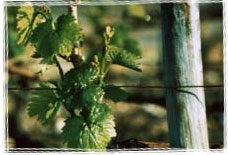
This is the period when the vegetation’s only requirement is to burst into life. One can feel all the tension.
The rising of the sap marks the end of pruning. It is the final snip of the shears to sculpt the vines for the rest of the year. (Guyot pruning) Spore contamination (eutypiose) is thus controlled by this natural barrier.
The 1st ploughing of the soil deters weed growth with the help of nitrogen fertilizer. The rhythm of frequency is approximately every three weeks, according to precipitation levels.
The state of trellising must then be checked carefully and repaired before attaching the cane. Fastening lasts approximately 3 weeks.
The canes are pulled down on the pruning wire in such a way to mark the bend and stop future vegetation from tangling. During the month of May, after the tension of spring frost has past, it is necessary to severely prune the undesirable new shoots. This operation is referred to as green pruning, summer pruning, or even sucker removing… Aeration, potential yield and future pruning are the parameters which guide each operation.
It is also the moment of the first mildew contamination and the procession of timed treatments according to the temperature and precipitation levels.
The growth of vines sometimes happens so fast in June that we don’t stop running from one parcel to the other to trellis, afraid if a new branch will be break by wind or rain… or under their own weight.
Protection against oidium begins by the 7th leaf. The 1st trim takes place around flowering and is repeated approximately every 15 days.
SUMMER
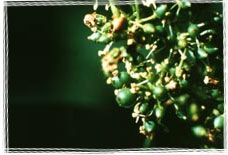
The “lifting” ends in mid-July while the ploughing continues. We touch up the evasivage, then we try to regulate the harvest according to the “style” of grapes given by the year: it is the green harvest.
It takes us about three weeks to “finish” the vines. All these operations are accompanied of a strict health care of our plots (mildew, powdery mildew, rot, worms, spiders, Eutypiose, esca, pyrales, …)
The last fungicide treatment takes place around mid August as well as the last tillage.
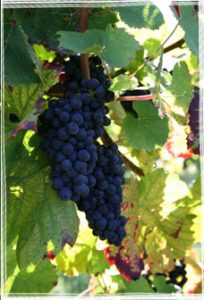
In early September, the last trimming is done. Then, we remove the trellis hooks to facilitate the harvest in “to lighten” the foliage and grapes.The harvest is the death knell of summer.
Autumn
The harvest was usually taking place between mid of September and the 1st days of October but with Global Warming the last years we started picking at beginning of September.
The sampling of maturity, the sanitary state of the grapes, and the weather forecasts all determine the date of harvest. Seasonal workers are recruited for approximately one week.
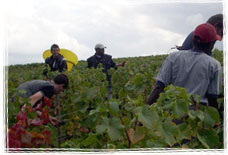
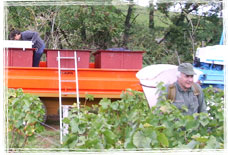
The grapes are sorted at harvest and removed from the parcel by back baskets. Small containers of 500 kg are transported regularly to the winery where we sort out a second time to obtain the best grapes quality.
The vegetative cycle has ended, the sap falls again, the leaves turn colour quickly (gold and purple) then fall off with the 1st frost.
Mechanical prepruning can begin as soon as the ground is solid. In mid-November, we begin winter pruning eliminating the old wood.
Winter
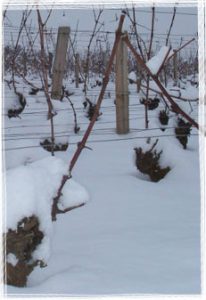
The vine is dormant. Pruning and burning the canes are habitual tasks.
The frost exercises its mechanical and sanitary action. Only snow and extreme frost interrupt the work in the vineyard.
